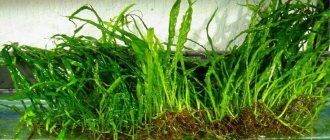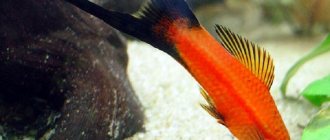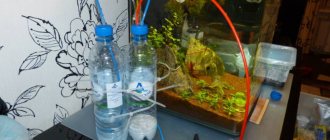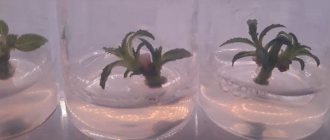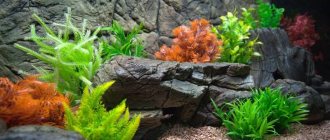4.7
(24)
Decorating an aquarium is, although a fascinating, but rather difficult process. It is necessary to carefully select plants so that they do not interfere with each other and at the same time are compatible in terms of living conditions. However, there are unpretentious and quite versatile plant species that appeal to both experienced aquarists and beginners. For example, this includes the Thai fern.
Habitat and appearance characteristics
The plant's homeland is Southeast Asia. It is distinguished by long roots with many thin branches.
It very rarely exceeds 30 cm in growth and is distinguished by its bright emerald, elongated, pointed leaves with a clear vertical orientation.
have been found , the fern belongs to the Centipede family .
It grows under water, but can also get out onto land. It has a low growth rate, and if conditions are as favorable as possible, it easily grows, filling all available space.
Spreading
The natural habitat of Microsorum pteropus is Malaysia, Thailand, northern India and some regions of China.
In Europe and America, the Thai fern is better known as Java fern or Java fern.
This is due to another place of its distribution - the island of Java in Indonesia.
In nature, it attaches itself using its root system to stones, roots or tree trunks. Sometimes you can find a plant immersed in the substrate.
This fern grows like a weed, so in its natural habitats there are no clear indications of its preferred conditions - water quality, amount of light and flow. In nature, some types of ferns can be found near waterfalls, rivers or streams in tropical forests.
Types of Thai fern
The following varieties of Thai fern are most often found in pet stores.
Narrow-leaved (Microsorum pteropus narrow)
A beautiful compact bush 24–26 cm in height. It is distinguished by a developed root system, which can reach more than 14 cm in length.
Participates in the creation of decorative compositions in artificial reservoirs. Pairs well with driftwood or castle ruins made from artificial materials.
Thai fern Undulata (Microsorum pteropus undulata)
Finding this soft green variety on sale is a rare success. The plant is capricious, distinguished by its smaller size and beautiful wavy edge of the leaf blades.
Philippine pterygoid (Pteropus philippine)
This variety gained popularity relatively recently. This is explained simply: the fern prefers marine aquariums, and maintaining such an ecosystem is more difficult.
It will be difficult to select the appropriate pH and water hardness in a fresh aquarium. But the plant is beautiful, very graceful. Without a doubt, it will decorate the composition.
Vindelov
Thanks to the unusual shape of the leaf blades, split at the ends, this is perhaps the most decorative plant for an artificial pond. In addition, the fish do not eat this variety.
Tropica (Pteropus tropica)
An adult plant can produce leaf blades up to 40 cm long, but young bushes are quite compact (about 25 cm).
This variety resembles a dandelion rosette and is best used for decorating backdrops in aquariums. Conditions of detention are standard.
Fork leaf (Microsorum pteropus fork leaf)
Quite a rare guest for domestic artificial reservoirs. It is distinguished by its compact size, slow growth and ease of care.
Interesting! Another name for it is “horned”.
Real narrow
It is distinguished by very narrow, only 4 mm, dark green leaf blades. Roots well on driftwood and other decorative elements.
Small leaf
Perhaps the smallest aquarium fern has leaf blades of only 4–6 cm. The maintenance conditions are standard.
Red microsorum (Pteropus red)
The peculiarity is the red color of young sprouts, but with age they turn green.
What problems may arise
Thai fern is hardy and stress-resistant. The main problem that aquarists face when growing plants is a slowdown in growth caused by a deficiency of nutrients and valuable microelements. This can be avoided by applying liquid fertilizers in a timely manner.
In addition, it is necessary to monitor the acidity of the aquatic environment, since when it increases strongly, the fern leaves begin to turn black and deteriorate. When digging up the ground, bottom-dwelling fish can damage and injure the weak roots of an aquatic plant, preventing its growth and reproduction, so it would be better to avoid such a neighborhood.
Maintenance and care
Thailand fern is one of the most unpretentious crops for aquarium keeping.
It does not need a ground base; it feels great on snags and stones.
But here the owner will need a certain dexterity: the plant needs to be tied to the support with its roots, and then it will braid itself around it and hold on perfectly.
The greenery will not suffer from the lack of direct sunlight, but additional lighting will have to be provided, although the fern feels and grows well in shaded ponds.
In addition, it is characterized by a slow rate of development, which allows it to be placed even in small vessels .
The optimal environment for the Thai fern will be soft, slightly acidic waters.
Important! Periodically, after hygienic cleaning of the aquarium, add a small amount of liquid fertilizer to feed. Dry or tablet forms of fertilizing are not suitable, since the fern does not have a rhizome.
Aquarium parameters
How spacious the reservoir is is not of great importance for the Thai fern.
It exists perfectly both in microsystems and in large panoramic tanks , eventually growing into dense thickets.
It is important not to touch the fern and try to replant it as rarely as possible.
View this post on Instagram
Posted by @moscowstreetfishing Jan 12, 2021 at 11:39 PST
Water
It is optimal for ferns to fill with soft water no higher than 6 dH and keep the acidity within 5–8 pH.
Lighting
Considering the natural habitat of the plant, it is necessary to provide long daylight hours for good growth and development of the fern - at least 12 hours.
For a luminous flux of such duration, you will have to turn on the backlight lamps.
Priming
The composition of the substrate does not matter, since the root system of ferns is located above the soil part . The plant receives nutrition directly from water, without taking root in the soil.
How to plant
Since the bush does not require rooting, planting does not cause any difficulties.
Over time, the root system itself clings to decorative elements , but to create a beautiful composition you will have to lay a special mesh.
How to fix it on a stone or driftwood
There are several ways to attach a fern to a decorative element:
- Using a fishing line. The advantages of the method include the transparency of the thread and its strength (nylon will not dissolve or rot in water), but care must be taken. The fishing line will easily cut the delicate roots, so you shouldn’t be zealous when tightening the knots.
- With a thread. They can be found in every home; they can be used to easily fix roots on a decorative element. The main disadvantage of thread fastening is that over time it will dissolve in water.
- Wire. It is important to choose an inert alloy that will not oxidize or rust.
- Using glue "Moment". Keep in mind: roots exposed to glue will die. Therefore, for fixation, use only 2-3 drops of waterproof glue and press one branch at a time so as not to touch the entire rhizome and not destroy the plant.
Mineral feeding
Feeding to stimulate growth should be applied regularly, after each cleaning of the aquarium .
You need to use liquid complexes, because the plant receives its nutrition directly from water and solid additives will not be of any use.
Landing rules
Planting a fern in an aquarium is quite simple. As a rule, this plant develops quickly on any soil without providing it with carbon dioxide, if it is artificially attached to some heavy object, for example, a stone or massive snag. Slow growth is considered a definite advantage, since there is no need for frequent pruning of green spaces and removal of unnecessary shoots.
The fern propagates by dividing the rhizome or transplanting young plants budding from the leaves of the mother plant.
To plant Thai fern in your underwater world, you can use different methods. Any of them are good and easy to use for both beginners and professional aquarists. Products that can be used to decorate an aquarium at home:
- Fastening using a simple fishing line.
- Attaching the fern to driftwood or stones using nylon thread.
- Use of rubber bands. This type of fastening is the most reliable, but it will look unattractive in the aquarium.
- Quite often, people use waterproof super-glue of the “Moment” type to attach ferns to the aquarium. However, in this case, you should not completely cover the plate with adhesive; it should only be applied in a few drops in the required places. At the point of gluing, the roots will fall off, but by this time the plant will have time to grow and will sit firmly on the support.
Compatibility with other inhabitants in the aquarium
In general, the fern can coexist with any species of fish , since its greens contain enzymes that make it inedible. But the best neighbors for ferns will be:
- swordtails;
- guppy;
- angelfish.
Among the plants nearby, hornwort and cryptocoryne do well.
Why is it useful?
The Thai fern is characterized by the presence of the following useful qualities, which determine its popularity among aquarists:
- creating a beautiful aquarium design without unnecessary effort;
- release of large amounts of oxygen;
- the formation of bushy thickets, extremely comfortable for resting, playing and breeding of small fish and fry;
- water purification, performing a filter function.
This culture, despite its unpretentiousness, with proper planting and reasonable care, looks very attractive and creates an impressive design.
average price
Buy plants for your aquarium in specialized stores, and not from others.
The average price for a young plant can be within 150 rubles , but the Vindelova fern costs more - about 250 rubles .
By purchasing this exotic plant for his aquarium, the owner solves several pressing problems: decoration of the reservoir, its aeration and purification.
In addition, the fern is distinguished by its unpretentiousness and long life cycle, which, of course, makes it a favorite among other aquarium plants.
Reproduction
The method of propagation of the Thai plant is vegetative; propagation occurs with the help of small shoots - shoots that grow on adult leaves. The shoot is carefully separated from the main plant and planted in a new place, securely fixed. The growth of a young shoot takes a couple of weeks, but during this time it is necessary to monitor water parameters and care for the future underwater inhabitant.
When purchasing seedlings in stores, experienced aquarists recommend carefully inspecting them for rot, broken roots and other abnormalities before purchasing. The future growth and health of the fern depends on the condition of the shoot. Do not forget that along with the purchased plant you can introduce harmful organisms into the aquarium, so such caution will not be superfluous.
The Thai fern is an attractive aquarium plant that will be a real salvation for owners of herbivorous fish. But in other bodies of water, the microzorium will also be useful - it will decorate the underwater space and serve as a shelter for the fry.
conclusions
The article is an introduction to the most popular types of Indian fern. If you want to add an aquarium fern to your home, check whether the aquarium is exactly suitable for its living conditions. Although in fact it is still worth looking for a less whimsical aquarium plant. The differences between them are not that big, so when choosing, be guided by the fact that you yourself like the new plant in your aquarium!
Previous
PlantsAquarium plants: types, description, photos, names, artificial, care, correct choice, compatibility, diseases
Next
PlantsSalvinia (fern): types (floating, eared, spruce, giant), maintenance, care, reproduction, water parameters, nutrition, pruning
Great article 0
Diseases
Thailand fern is an unpretentious plant. He has no diseases as such. Damage can be caused by improper actions taken by the aquarium owner to care for the fern. Therefore, strict adherence to recommendations for the quality of lighting, chemical composition of water and temperature conditions will keep the plant in excellent condition for a long time.
If you find wilted leaves, carefully cut them off using scissors. This action will allow new leaves and roots to grow.
Lighting for microsorums
The only drawback of microsorums, or rather the parameter in which they are inferior to classic indoor ferns, is their light-loving nature. Microsorums need bright lighting, but with protection from direct sunlight. Eastern and western window sills are considered ideal for these ferns. In winter, it is advisable to adjust the lighting, increasing it to create a more stable environment. The fern responds well to additional lighting.
Now some varieties of microsorums have appeared on sale that do well in light partial shade and are accustomed to shade. It is better to check the lighting parameters that are comfortable for the plant when purchasing.
How to plant correctly
Thai ferns grow well in any soil. For the full development and formation of the bush, it is recommended to tie it to stones and snags.
Since the aquatic plant performs a filtering function, many aquarists prefer to place it in the center of the reservoir for complete water purification. The aquarium can be of any size, but the plant thrives and looks best in deep and spacious containers.




